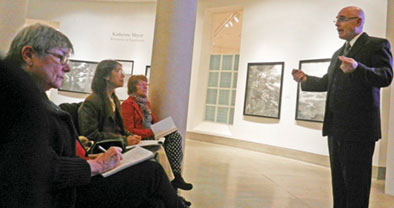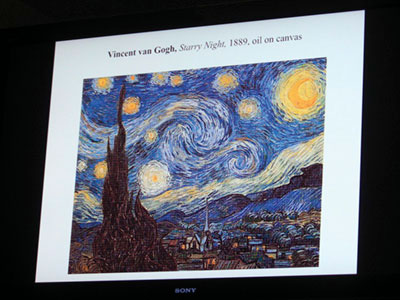
In the course of two weeks, the Triton Museum of Art’s Chief Curator Preston Metcalf has begun the task of describing the criteria for an artistic masterpiece. It’s been a journey, as the criteria are multi-faceted and complex. The adventure continued on Feb. 20 in the third installment of the “A Curator’s Eye: Discerning a Masterpiece” lecture series.
“We’ve been talking about what are the criteria for a masterpiece,” said Metcalf. “This whole series was born out of having professionals in the field say ultimately all art is subjective. And my head would start to explode because art is not a subject that is subjective – what you like is subjective. There are criteria for great paintings. There are criteria for great sculptures just as there is for great writing or making great scrambled eggs. There’s a right and a wrong way to do everything so we’ve been talking about the criteria.”
Thus far, it’s been said that a masterpiece must have ambivalence, irony, strangeness, originality, aesthetic splendor, and creatively misread its precursors. The checklist continued as Metcalf detailed how a masterpiece must have cognitive power and be a metaphor.

In looking at Edouard Manet’s “The Luncheon on the Grass,” – a piece that was originally considered a disgrace – Metcalf said that Manet was speaking about his time. “He understood what was happening around him,” said Metcalf, “and he used visual art to try to portray that knowledge … That’s what we mean by cognitive power. This next element that is a requisite for artistic greatness is metaphor or the desire to be elsewhere. Metaphor instills a desire in us to be elsewhere because it makes us think of something different. So I can’t overstate this enough, all great art is a metaphor. All great art is a metaphor. If it is not a metaphor it is not and will not ever be great art.”
Metcalf explained artistic metaphor by showing Vincent Van Gogh’s “Work Boots,” “Sunflowers” and “Starry Night,” each of which are self-portraits. They push the viewer to look beyond what is painted to see the real meaning. “[They’ve] pitched us out of our stasis,” said Metcalf. “[They’ve] put us into a new place and done something to us. [They’ve] opened our hearts to compassion. That is greatness. When art can do that, it is greatness.”
“Great art is myth,” he continued. “Great art is metaphor. There is no separation between art, literature, philosophy, belief systems … and they all serve the same four functions,” which are metaphysical (makes the viewer aware of something greater than themselves), cosmological (explains the world around them), sociological (makes the viewer exist within the world), and pedagogical (how the views are assimilated). “The greatest art does all of this so these are related to the metaphor of art. In any great art, you can analyze this way.”
The series continues on Thurs., Feb. 27 with a lecture on how masterpieces demand self-change through subject inwardness and re-experiencing. Lectures begin at 7 p.m. Drop in fee is $20. The Triton Museum of art is at 1505 Warburton Ave. in Santa Clara. Visit http://tritonmuseum.org/education_adults_arthistory.php





